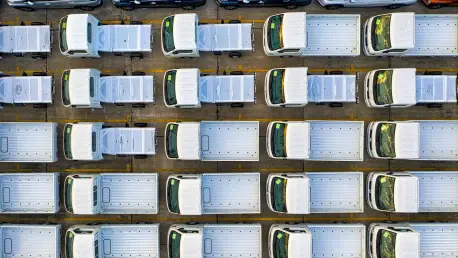What does it take to transform an industry as critical as logistics into a beacon of sustainability, and how can such a shift redefine the way we think about delivery systems? Picture this: a convoy of silent, zero-emission trucks gliding across the iconic Humber Bridge, hauling millions of packages without a puff of exhaust. Amazon has turned this vision into reality by launching the largest fleet of electric heavy-goods vehicles (eHGVs) in the UK, a bold stride toward greener delivery systems. This groundbreaking move isn’t just about swapping diesel for electric—it’s a challenge to the status quo, promising cleaner air and quieter streets for communities nationwide.
The significance of this initiative cannot be overstated. Transportation remains a major source of carbon emissions in the UK, contributing heavily to urban pollution and climate change. With 160 cutting-edge eHGVs already operational, Amazon is not only addressing these pressing environmental concerns but also setting a new standard for the logistics sector. This fleet, supported by innovative infrastructure and partnerships, marks a pivotal moment in the journey toward net-zero targets, proving that large-scale sustainability in delivery is not just possible but already underway.
A Monumental Step Toward Sustainable Logistics
At the heart of Amazon’s ambitious rollout are 160 eHGVs, the largest such fleet in its global network. These 40-ton Mercedes-Benz eActros 600 trucks can carry up to 22 metric tons and travel over 310 miles on a single charge, covering distances equivalent to 450 trips around the Earth each year. Already, these vehicles are moving over 300 million products annually between key logistics hubs, showcasing a scalable model for decarbonizing freight transport.
This deployment isn’t happening in isolation. Amazon has invested heavily in fast-charging infrastructure, installing 360kW chargers at its UK sites that can power trucks from 20% to 80% capacity in just over an hour. Supported by the UK Government’s Zero Emission HGV and Infrastructure Demonstrator program in collaboration with Innovate UK, this initiative reflects a powerful blend of corporate innovation and public policy, paving the way for broader industry shifts.
The Urgent Need for Electric Fleets
The logistics sector faces immense pressure to reduce its environmental footprint, especially as transportation accounts for a significant portion of the UK’s carbon emissions. With urban air quality deteriorating and net-zero goals looming, the transition to zero-emission vehicles offers a tangible solution to these challenges. Electric fleets like Amazon’s directly combat pollution while cutting down on noise, an often-overlooked benefit for densely populated areas.
Beyond environmental gains, this shift addresses growing public and regulatory demands for sustainable practices. Cities are increasingly restricting diesel vehicles in urban zones, making electric trucks not just an ethical choice but a practical necessity. Amazon’s investment signals to other companies that the time to adapt is now, as delays could mean falling behind in both compliance and consumer trust.
Unpacking a Comprehensive Green Strategy
Amazon’s sustainability efforts extend far beyond eHGVs, encompassing a multifaceted approach to eco-friendly delivery. Over 800 Mercedes-Benz eSprinter vans have been added to the UK fleet, designed with custom shelving and sliding bulkhead doors for enhanced safety and efficiency. These vans complement the larger trucks, ensuring that even last-mile deliveries align with zero-emission goals.
Additionally, pedestrian delivery programs are gaining traction in London boroughs such as Camden. Over one million packages have been delivered on foot using vans as mobile hubs, significantly reducing traffic congestion and improving air quality. This innovative model demonstrates how rethinking traditional delivery methods can yield substantial community benefits, especially in crowded urban centers.
Each component of this strategy—trucks, vans, and walking deliveries—is supported by strategic infrastructure investments. The synergy of these elements underscores a holistic vision for logistics, one that balances operational efficiency with environmental responsibility, setting a benchmark for others to follow.
Insights from Leaders Driving Change
The impact of this electric revolution resonates through the voices of key stakeholders. Heiko Selzam of Daimler Truck UK Limited describes the eActros 600 as a “game-changing asset” for long-haul logistics, emphasizing its role in enabling companies to rethink supply chains. This perspective highlights the technological leap that makes such ambitious fleets viable.
Local leaders also see immense value in these initiatives. Councillor Adam Harrison from Camden applauds the pedestrian delivery trials, noting their alignment with the borough’s sustainability objectives and potential to shape future freight policies. Meanwhile, Nicola Fyfe, EU VP of Amazon Logistics, points to a critical gap: insufficient charging infrastructure across the UK. Fyfe’s call for industry and government collaboration underscores that while progress is evident, systemic hurdles remain a significant barrier to mass adoption.
Charting the Path to a Cleaner Tomorrow
Looking ahead, Amazon’s efforts provide a roadmap for businesses and policymakers eager to embrace sustainable logistics. A starting point lies in leveraging government-backed programs, as seen with the funding that bolstered this eHGV rollout, to offset the high initial costs of electric fleets. Such partnerships can accelerate the transition for companies of all sizes.
Equally important is the need to pilot alternative delivery models, like pedestrian systems, in collaboration with local authorities. These trials can reduce urban congestion while gathering data to refine broader applications. Most urgently, as Fyfe highlighted, building a national charging network must become a priority—without it, the scalability of electric vehicles in logistics will stall, limiting the potential for widespread environmental impact.
Reflecting on this milestone, Amazon’s launch of 160 eHGVs, paired with electric vans and on-foot deliveries, stands as a defining moment in the UK’s logistics landscape. It showcases how technology and collaboration can slash emissions and ease urban strain. Yet, the journey doesn’t end there; the persistent need for robust charging infrastructure looms as a challenge to overcome. Moving forward, the industry must unite—businesses, governments, and communities alike—to invest in solutions that will sustain this momentum. Only through such collective action can the vision of a fully decarbonized freight system transform from aspiration into lasting reality.









